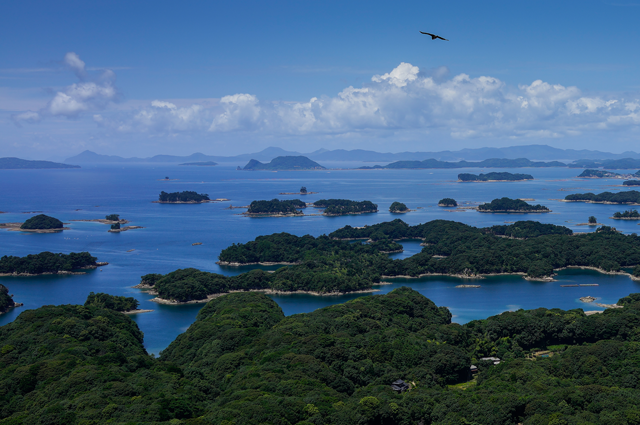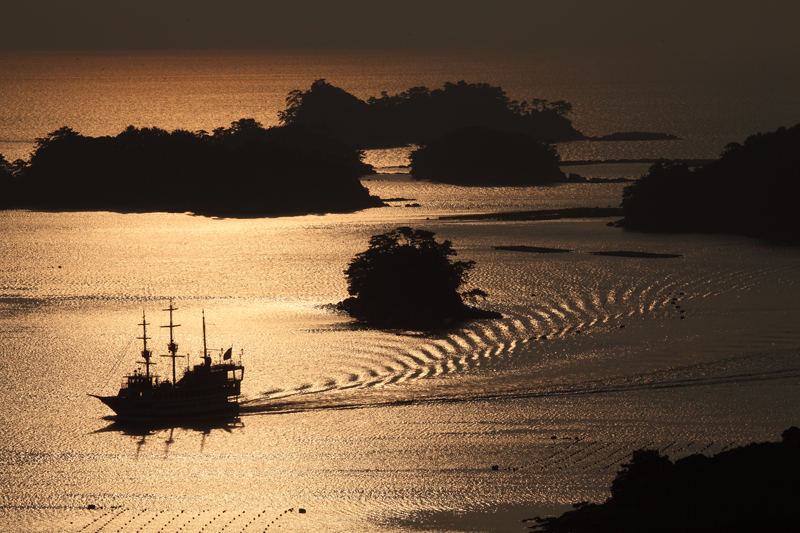Settle into a relaxed frame of mind as you sample the delights of this marine getaway.
By Robert Morel
Located on the northwestern edge of Kyushu’s westernmost prefecture, once a small fishing village, Sasebo has grown to become Nagasaki’s second largest city. This city of the sea is now home to Japan’s westernmost marine national park, fisheries supplying the freshest seafood, and stunning views of the isles and waters beyond. Thanks to the Japanese SDF and US Navy bases, the town has also grown into a quiet commercial center with a range of cuisines, shopping, and nightlife.
Islands Beyond Number
Off the coast of Sasebo, at the westernmost tip of Japan, is the Kujukushima archipelago. What were mountains many millennia ago are now tiny islands beyond islands, as far as the eye can see, a collection of brown-gray sandstone cliffs topped with lush groves of Japanese pines. The result is a seemingly infinite collection of uniquely shaped sandstone isles, hidden coves, and an artist’s palette of blues and greens. Kujukushima, which translates to “ninety-nine islands,” refers not to the number (there are actually 208), but to the fact that in times past there were simply too many to count. Of these, only four are inhabited. The rest are home to a range of wildlife, while the sea and inlets host a beautiful variety of aquatic life as well as oyster and clam beds for local pearl cultivation. While the vista from any of the area’s four observation towers is impressive, the best way to experience the archipelago is from the water. From the Kujukushima Pearl Sea Resort, visitors can step onto the decks of the Pearl Queen for a 50-minute cruise around the isles. Standing at the bow, feeling the ocean breeze as the captain slowly weaves between islands, it is easy to forget the roads, buildings, and bustle of civilization. Even Sasebo seems worlds away, and Tokyo nothing but a distant memory. In the waters below translucent jellyfish—different colors and kinds depending on the season—flow with the current, unperturbed by the rise and fall of the ship’s wake. The ship passes by an island that looks like a sleeping lion, navigates the maze of coves, and slips between a pair of islands so close it feels like if you stretched out—just a little more—you could brush the edge with your fingers. Returning to port, what felt like a timeless journey is over in the blink of an eye.
Before venturing back into the city, though, visit the Umikirara Aquarium to get up close and personal with dolphins, jellyfish, and of other creatures of the sea. Highlights include an impressive dolphin show, an aquarium that simulates a walk under the sea, a variety of beautiful rare jellyfish, and a number of hands-on “experience” areas popular with children.
Japan’s First Burger
According to local lore, thanks to the nearby US Navy base Sasebo was home to the first real American-style hamburgers in Japan. As with many Nagasaki area foods though, it was quickly transformed into something unique—the now famous Sasebo burger. There are a number of requirements to qualify as a real Sasebo burger—it needs to have quality beef, thick cut bacon, a special 9-spice mayonnaise, and a special bun, among others. While there is now a range of shops specializing in Sasebo burgers, for over 40 years, LOG KIT has been one of the premier shops to try this hearty local fare. The interior of this multi-generation, family run shop, with its dark wood tables and energetic staff, feels like a museum of classic Americana collected over time. And the burgers more than live up to their reputation. The bun, made at a local Sasebo bakery, is tender and chewy, a perfect frame for the rich, flavorful burger inside. Between the homemade sauces, egg, and juicy beef patty, eating a Sasebo burger is far from tidy. Putting one down half way through without it collapsing seems dubious. In short, it’s exactly what a burger should be. After all, with something this good, why would you stop eating long enough to put it down anyway?
Gramophone
Few, if any, other bars manage to combine the atmosphere of a 1960s US roadhouse and Showa-era Japanese snack bar. Whether through design or sheer chance, Gramophone, located in Sasebo’s “Sailor Town” pulls it off seamlessly. The ceiling and wall behind the bar are covered in dollar bills bearing the signatures of sailors and visitors—mementos of often never fulfilled promises to return, slips of paper left as proof that for a short time, they were here, that this place meant something in their lives. The oldest of these bills, yellowed with age, belie Gramophone’s 30-plus years of service to visitors and locals alike. Past the long wooden bar, with its friendly staff and lines of bottles, the shop opens into a room of red velvet booths and low tables. If the entrance feels like a 1970s roadhouse, then the back resembles a once-classy snack, or Japanese lounge bar from the same era. On a Saturday night, the bar is filled with a mix of locals, Navy officers from the nearby base, and the occasional visitor from Tokyo or abroad. The atmosphere is jovial without being raucous, the kind of place where you can strike up a conversation with a stranger or just as easily take in the atmosphere and people watch by yourself.
Updated On December 26, 2022











